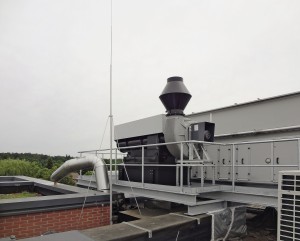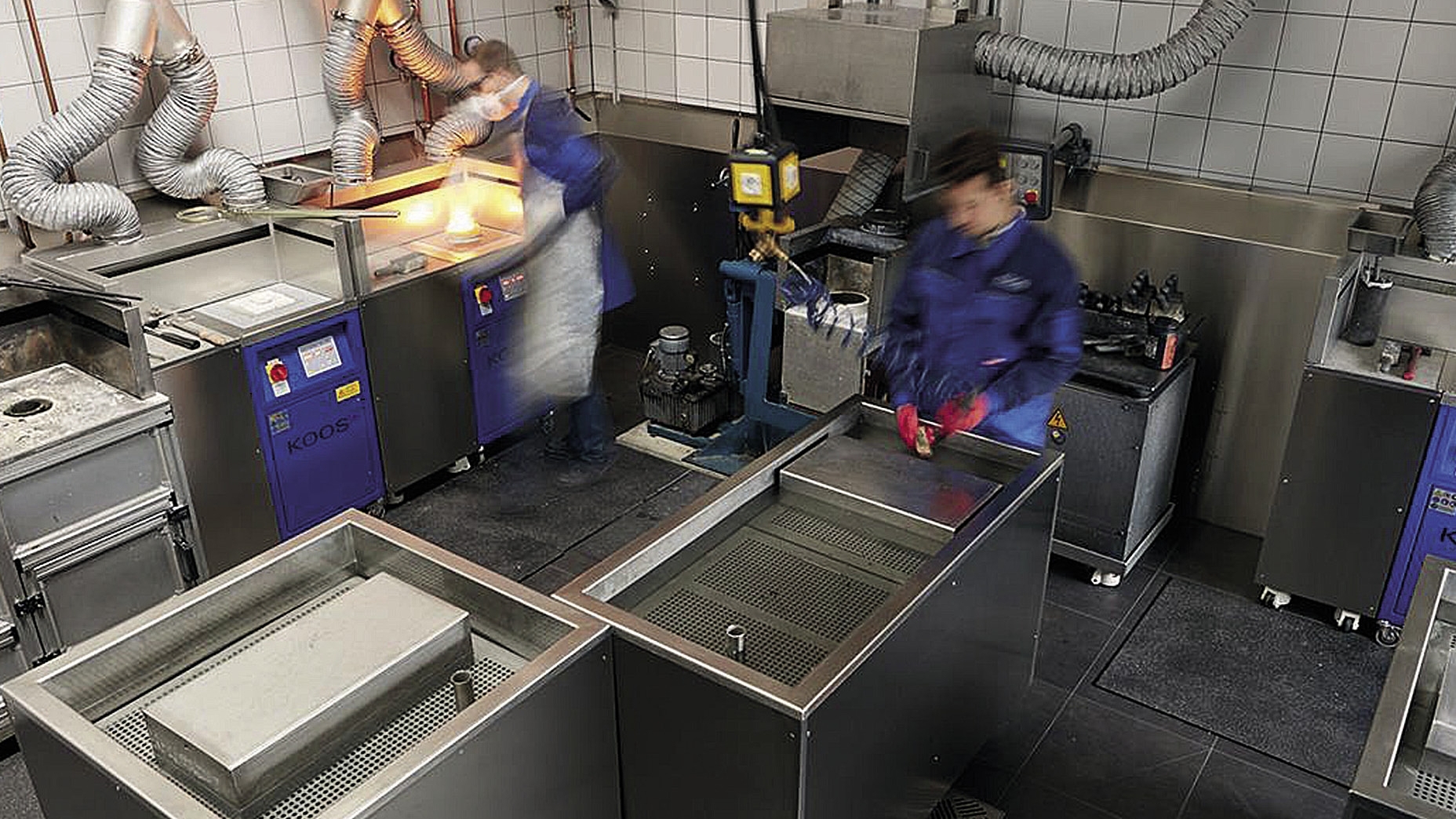As part of the modernization of the analysis laboratories, the exhaust air technology at Koos was also brought up to the latest technical standard. The exhaust air concept was implemented by Honer Lufttechnische Anlagen from Spaichingen in accordance with TA-Luft regulations. A special air flow management system with adjustable volume flows saves energy and takes account of the special process sequences.
Acidic exhaust air during precious metal separation
 A hinged cover made of powder-coated aluminum protects against the effects of the weather At Koos Edelmetalle GmbH in Renningen, everything revolves around gold, silver, platinum and other precious metals: the company has been offering a comprehensive service for precious metals for 40 years. The company's portfolio ranges from recovery and recycling to jewelry, investments and dental alloys.
A hinged cover made of powder-coated aluminum protects against the effects of the weather At Koos Edelmetalle GmbH in Renningen, everything revolves around gold, silver, platinum and other precious metals: the company has been offering a comprehensive service for precious metals for 40 years. The company's portfolio ranges from recovery and recycling to jewelry, investments and dental alloys.
Strict environmental protection regulations apply to all operations in the recovery of precious metals. The existing plant for separating precious metals was getting on in years. It was therefore time to modernize the plant and bring the exhaust air purification system up to the latest state of the art.
Exhaust air purification in the cross-flow scrubber
To recover precious metals, parts containing precious metals are first melted and homogenized. The result is the so-called planche (solidified melting body). After the removal of impurities and slag deposits, several analysis steps follow, which can be used to determine the proportions of gold, silver, platinum and palladium contained in the slab. The precious metal separation, the actual recovery of the precious metals contained, is then carried out on this basis. The separation process requires the complete dissolution of the precious metals in suitable acid mixtures. Nitric acid or hydrochloric acid, for example, are used for this purpose. Acidic exhaust air is produced, which is continuously extracted in the digestion rooms (fume cupboards) and fed into the exhaust air flow. The polluted exhaust air is then fed into the exhaust air scrubber and cleaned.
The polluted exhaust air is cleaned in a horizontal Airtop KS-H exhaust air scrubber from Richard Tscherwitschke GmbH. This works on the principle of a cross-flow scrubber. The recirculated scrubbing water is sprayed against the exhaust air flow via a nozzle system. In the spray mist, the pollutants contained in the exhaust air are absorbed on the large surface of the many water droplets. Finally, the exhaust air is separated from the entrained droplets in the downstream droplet separator. The contaminated water is collected, neutralized with caustic soda and fed back into the washing cycle.
Various sensors and control units monitor and regulate the exhaust air purification process: an immersion probe continuously measures the water level, a pH probe monitors the pH value and a control unit automatically triggers the dosing of the neutralizing agent and the replacement of water.
If the pH value exceeds a set limit value, a neutralizing agent is automatically added. Despite neutralization, concentration increases over time: The enrichment of the water with pollutants increases so that it has to be salted from time to time. Some of the wastewater is then pumped out and replaced with fresh water. The waste water is fed into the sewage system.
Fresh water must also be added from time to time due to evaporation. The water level is measured using a float switch. As soon as water needs to be added, a solenoid valve opens the inflow. As a further measure for environmental protection, the fume scrubber has been equipped with a safety tray and a leakage probe.
Flexible air volume flow saves energy
 "Under the hood": The new Airtop KS-H exhaust air scrubber on the roof of Koos Edelmetalle GmbH in Renningen. Photo: Richard Tscherwitschke GmbHTheoutput of the exhaust air system is in a variable range with an adjustable air volume flow. The demand depends on how many of the connected digestors are in operation. The fan, which is controlled by a frequency converter, allows the air volume to be flexibly adapted to the actual demand. If, for example, not all the digestors are in operation at the same time or if the operation of one of the digestors is shut down, the air volume flow is reduced to the required minimum, thus saving energy.
"Under the hood": The new Airtop KS-H exhaust air scrubber on the roof of Koos Edelmetalle GmbH in Renningen. Photo: Richard Tscherwitschke GmbHTheoutput of the exhaust air system is in a variable range with an adjustable air volume flow. The demand depends on how many of the connected digestors are in operation. The fan, which is controlled by a frequency converter, allows the air volume to be flexibly adapted to the actual demand. If, for example, not all the digestors are in operation at the same time or if the operation of one of the digestors is shut down, the air volume flow is reduced to the required minimum, thus saving energy.
For space reasons, the fume scrubber had to be installed on the roof of the Koos company. It was made fit for outdoor use: a hinged protective cover made of powder-coated aluminum protects it from the weather. The housing is made of UV-resistant polyethylene and is well insulated against cold and heat. To keep the temperature of the wash water above freezing, the fume scrubber is also equipped with a bath heater with temperature sensor. The fresh water and waste water pipes also both have trace heating. In addition, care has been taken to ensure that components that require regular maintenance or cleaning are easily accessible thanks to large openings and an appropriate arrangement, such as the droplet separator.
Honer At a glance:
Honer Lufttechnische Anlagen GmbH + Co KG, based in Spaichingen, has been offering an all-round service for modern air management for over 50 years, from planning to installation. The spectrum ranges from simple supply and exhaust air systems to complex ventilation and air conditioning tasks. From commercial operations to operating theatres - the systems implemented by Honer cover a wide range of applications and are also used in challenging spatial and architectural conditions.
www.hone r-luft.de
Richard Tscherwitschke at a glance:
Richard Tscherwitschke GmbH has been developing and producing exhaust air purification systems for wet-chemical plants since 1970. These systems are used in various industries for the separation of hydrophilic gaseous and aerosol pollutants. The focus here is on supply air and exhaust air management with the best possible efficiency, closed circuits for the recovery of energy and valuable materials, absorption scrubbers, vapor condensers and also droplet separators.
www.tsch erwitschke.com


